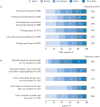Understanding the impact of pulmonary arterial hypertension on patients' and carers' lives
- PMID: 24293469
- PMCID: PMC9639179
- DOI: 10.1183/09059180.00005713
Understanding the impact of pulmonary arterial hypertension on patients' and carers' lives
Abstract
Pulmonary arterial hypertension (PAH) is a rare, debilitating and rapidly progressive disease. Although there have been important medical advances in PAH management, the search for a cure continues. Despite an increased understanding of the disease, data on the wider effect of PAH on patients and carers, beyond the clinical symptoms, are still limited. In order to explore this, a large-scale international survey investigated four key areas affected by PAH (physical and practical, emotional, social, and information needs) and provides new insight into patients' and carers' experiences of living with the disease. The results from the survey highlight not only the limited ability of patients to carry out everyday tasks, but also the financial impact and social isolation experienced by both patients and carers. The study confirmed that a decline in a patient's World Health Organization functional class, which indicates an increase in clinical severity of the disease, is associated with greater limitations. Results from the survey demonstrate the need for multidisciplinary PAH management and a comprehensive standard of care to assess and improve all aspects of well-being for both patients and carers. In addition, they underline the need for updated PAH guidelines that address these needs.
Conflict of interest statement
Conflict of interest: Disclosures can be found alongside the online version of this article at
Figures



References
-
- Galiè N, Hoeper MM, Humbert M, et al. . Guidelines for the diagnosis and treatment of pulmonary hypertension: the Task Force for the Diagnosis and Treatment of Pulmonary Hypertension of the European Society of Cardiology (ESC) and the European Respiratory Society (ERS), endorsed by the International Society of Heart and Lung Transplantation (ISHLT). Eur Heart J 2009; 30: 2493–2537. - PubMed
-
- Rich S, Dantzker DR, Ayres SM, et al. . Primary pulmonary hypertension. A national prospective study. Ann Intern Med 1987; 107: 216–223. - PubMed
Publication types
MeSH terms
LinkOut - more resources
Full Text Sources
Other Literature Sources
Medical
